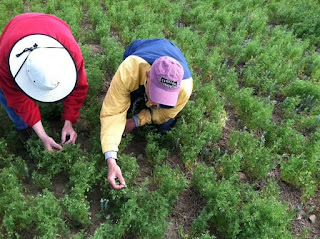Last week, I received the greatest call to-date during my service as a Montana FoodCorps member working with Flathead Valley Community College’s Farm to School program. On the line was Jennifer Montague, the Kalispell Food Services Director. “I didn’t know who else to call,” she said. “I couldn’t think of anyone else that would be excited by this.”
I straightened my back and pressed the phone close to my ear. What could it be? I wondered.
For the past three months, I’d been collaborating with Jennifer to source local produce for the Fresh Fruits and Vegetable Snack Program. In Kalispell, four different elementary schools qualify for this federal program which aims to get extra servings of healthy food into the bellies of kids in schools where 50% or more of the students are from low-income families.
But Jennifer and I had already celebrated the enthusiastic response to the fresh sliced cucumbers, Dixon melons, and fresh Flathead cherries, that we’d been serving from the Western Montana Growers Cooperative. Teachers had flagged us down in the halls to tell us that their young students were gobbling up the flavorful produce, which was not the case with the “slimy” prepackaged fruits and vegetables of previous years.
So I wondered, what new update had Jennifer so excited?
“The fruits and veggies that we’ve procured locally have been cheaper than those bought from [a national food service company that will remain nameless].”
My mouth fell open.
You see, one of the top concerns for those of us working on Farm to School is whether the local food will be too expensive, a factor that could make or break a nascent program such as ours.
But the more I’ve gotten to know people here in Montana, the more I’ve really wanted Farm to School to succeed. “Supporting local farmers” and “strengthening local communities” is no longer an abstract concept. For example, at a recent FoodCorps training, I met Jacob and Courtney, farmers who marry modern ecological principals with the values of their grandparents. My brother’s friend Steffen drives the truck for the Western Montana Growers Cooperative in Arlee. And my neighbor has introduced me to her friend Casey, who grows lentils and barley for the lentil burger the FoodCorps team is testing out in our schools this month.
Casey Bailey takes a break from growing crops for kids.
The list goes on: A chef in Whitefish. Board members for Nourish the Flathead. A co-founder of a natural foods company. I’ve listened to them all talk with such great passion about creating more local, sustainable and healthy food systems, and it’s warmed my heart to know I am a part of something so much larger.
But I’ve also worried about whether the Farm to School program I’m working on could really be an asset to this movement—to them.
Montana is big geographically, but the people are closely connected.
So Jennifer was right to expect that I would share her enthusiasm for what might seem to others like a minor budget detail.
“Awesome!” I said into the phone. Okay, maybe I even shouted. I smiled so hard my cheeks hurt. I hung up the phone and did a little dance around the office.
Ladies and gentleman, that’s it, I thought, I’m throwing in the towel—my work here is done. How can it get better than this?
But after a few more minutes of celebration, I sat back down to work. I believe that school food can, and will, get even better than this. And, like my new friends and colleagues working on Montana-based food systems, I’ll keep working hard to make it so.





No comments:
Post a Comment